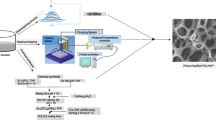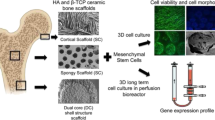Abstract
Internal pores in calcium phosphate (CaP) scaffolds pose an obstacle in cell seeding efficiency. Previous studies have shown inverse relationships between cell attachment and internal pore size, which mainly resulted from cells flowing to the bottom of culture plates. In order to overcome this structure-based setback, we have designed a method for cell seeding that involves hydrogel. CaP scaffolds fabricated with hydroxyapatite, biphasic calcium phosphate, and β-tricalcium phosphate, had respective porosities of 77.0, 77.9, and 82.5% and pore diameters of 671.1, 694.7, and 842.8 μm. We seeded the cells on the scaffolds using two methods: the first using osteogenic medium and the second using hydrogel to entrap cells. As expected, cell seeding efficiency of the groups with hydrogel ranged from 92.5 to 96.3%, whereas efficiency of the control groups ranged only from 64.2 to 71.8%. Cell proliferation followed a similar trend, which may have further influenced early stages of cell differentiation. We suggest that our method of cell seeding with hydrogel can impact the field of tissue engineering even further with modifications of the materials or the addition of biological factors.







Similar content being viewed by others
References
Abbott, A. Cell culture: biology’s new dimension. Nature 424(6951):870–872, 2003.
Cukierman, E., R. Pankov, D. R. Stevens, and K. M. Yamada. Taking cell-matrix adhesions to the third dimension. Science 294(5547):1708–1712, 2001.
Daculsi, G. Biphasic calcium phosphate concept applied to artificial bone, implant coating and injectable bone substitute. Biomaterials 19(16):1473–1478, 1998.
Damien, E., K. Hing, S. Saeed, and P. A. Revell. A preliminary study on the enhancement of the osteointegration of a novel synthetic hydroxyapatite scaffold in vivo. J. Biomed. Mater. Res. A 66A(2):241–246, 2003.
Degroot, K. Bioceramics consisting of calcium-phosphate salts. Biomaterials 1(1):47–50, 1980.
Delgado-Calle, J., C. Sanudo, L. Sanchez-Verde, R. J. Garcia-Renedo, J. Arozamena, and J. A. Riancho. Epigenetic regulation of alkaline phosphatase in human cells of the osteoblastic lineage. Bone 49(4):830–838, 2011.
Dorozhkin, S. V., and M. Epple. Biological and medical significance of calcium phosphates. Angew. Chem. Int. Ed. 41(17):3130–3146, 2002.
Dvir-Ginzberg, M., I. Gamlieli-Bonshtein, R. Agbaria, and S. Cohen. Liver tissue engineering within alginate scaffolds: effects of cell-seeding density on hepatocyte viability, morphology, and function. Tissue Eng. 9(4):757–766, 2003.
Hattori, H., K. Masuoka, M. Sato, M. Ishihara, T. Asazuma, B. Takase, M. Kikuchi, K. Nemoto, and M. Ishihara. Bone formation using human adipose tissue-derived stromal cells and a biodegradable scaffold. J. Biomed. Mater. Res. B 76B(1):230–239, 2006.
Hench, L. L., and J. M. Polak. Third-generation biomedical materials. Science 295(5557):1014–1017, 2002.
Hoffman, R. M. To do tissue-culture in 2 or 3 dimensions—that is the question. Stem Cells 11(2):105–111, 1993.
Holmes, T. C., S. de Lacalle, X. Su, G. S. Liu, A. Rich, and S. G. Zhang. Extensive neurite outgrowth and active synapse formation on self-assembling peptide scaffolds. Proc. Natl Acad. Sci. U.S.A. 97(12):6728–6733, 2000.
Holtorf, H. L., T. L. Sheffield, C. G. Ambrose, J. A. Jansen, and A. G. Mikos. Flow perfusion culture of marrow stromal cells seeded on porous biphasic calcium phosphate ceramics. Ann. Biomed. Eng. 33(9):1238–1248, 2005.
Horii, A., X. M. Wang, F. Gelain, and S. G. Zhang. Biological designer self-assembling peptide nanofiber scaffolds significantly enhance osteoblast proliferation, differentiation and 3-D migration. PLoS ONE 2(2):e190, 2007.
Hubbell, J. A. Biomater. Tissue Eng. 13(6):565–576, 1995.
Hutmacher, D. W. Scaffolds in tissue engineering bone and cartilage. Biomaterials 21(24):2529–2543, 2000.
Kim, Y. B., and G. Kim. Rapid-prototyped collagen scaffolds reinforced with PCL/beta-TCP nanofibres to obtain high cell seeding efficiency and enhanced mechanical properties for bone tissue regeneration. J. Mater. Chem. 22(33):16880–16889, 2012.
Kim, S. S., M. S. Park, O. Jeon, C. Y. Choi, and B. S. Kim. Poly(lactide-co-glycolide)/hydroxyapatite composite scaffolds for bone tissue engineering. Biomaterials 27(8):1399–1409, 2006.
Kim, S. M., S. A. Yi, S. H. Choi, K. M. Kim, and Y. K. Lee. Gelatin-layered and multi-sized porous beta-tricalcium phosphate for tissue engineering scaffold. Nanoscale Res. Lett. 7(1):78, 2012.
Koch, M. A., E. J. Vrij, E. Engel, J. A. Planell, and D. Lacroix. Perfusion cell seeding on large porous PLA/calcium phosphate composite scaffolds in a perfusion bioreactor system under varying perfusion parameters. J. Biomed. Mater. Res. A 95A(4):1011–1018, 2010.
Laurencin, C. T. N. L. S. Nanotechnology and Tissue Engineering: The Scaffold. Boca Raton: CRC Press, 2008.
McGrath, A. M., L. N. Novikova, L. N. Novikov, and M. Wiberg. BD™ PuraMatrix™ peptide hydrogel seeded with Schwann cells for peripheral nerve regeneration. Brain Res. Bull. 83(5):207–213, 2010.
Narmoneva, D. A., O. Oni, A. L. Sieminski, S. G. Zhang, J. P. Gertler, R. D. Kamm, and R. T. Lee. Self-assembling short oligopeptides and the promotion of angiogenesis. Biomaterials 26(23):4837–4846, 2005.
Nery, E. B., R. Z. Legeros, K. L. Lynch, and K. Lee. Tissue-response to biphasic calcium-phosphate ceramic with different ratios of Ha/Beta-Tcp in periodontal osseous defects. J. Periodontol. 63(9):729–735, 1992.
Olivares, A. L., and D. Lacroix. Simulation of cell seeding within a three-dimensional porous scaffold: a fluid-particle analysis. Tissue Eng. C 18(8):624–631, 2012.
Papadimitropoulos, A., S. A. Riboldi, B. Tonnarelli, E. Piccinini, M. A. Woodruff, D. W. Hutmacher, and I. Martin. A collagen network phase improves cell seeding of open-pore structure scaffolds under perfusion. J. Tissue Eng. Regen. Med. 7(3):183–191, 2013.
Park, J., S. Bauer, K. A. Schlegel, F. W. Neukam, K. von der Mark, and P. Schmuki. TiO2 nanotube surfaces: 15 nm—an optimal length scale of surface topography for cell adhesion and differentiation. Small 5(6):666–671, 2009.
Park, J., S. Bauer, P. Schmuki, and K. von der Mark. Narrow window in nanoscale dependent activation of endothelial cell growth and differentiation on TiO2 nanotube surfaces. Nano Lett. 9(9):3157–3164, 2009.
Pfister, A., R. Landers, A. Laib, U. Hubner, R. Schmelzeisen, and R. Mulhaupt. Biofunctional rapid prototyping for tissue-engineering applications: 3D bioplotting versus 3D printing. J. Polym. Sci. A 42(3):624–638, 2004.
Rose, F. R., L. A. Cyster, D. M. Grant, C. A. Scotchford, S. M. Howdle, and K. M. Shakesheff. In vitro assessment of cell penetration into porous hydroxyapatite scaffolds with a central aligned channel. Biomaterials 25(24):5507–5514, 2004.
Ryu, H. S., H. J. Youn, K. S. Hong, B. S. Chang, C. K. Lee, and S. S. Chung. An improvement in sintering property of beta-tricalcium phosphate by addition of calcium pyrophosphate. Biomaterials 23(3):909–914, 2002.
Sanchez-Salcedo, S., A. Nieto, and M. Vallet-Regi. Hydroxyapatite/beta-tricalcium phosphate/agarose macroporous scaffolds for bone tissue engineering. Chem. Eng. J. 137(1):62–71, 2008.
Schmittgen, T. D., B. A. Zakrajsek, A. G. Mills, V. Gorn, M. J. Singer, and M. W. Reed. Quantitative reverse transcription-polymerase chain reaction to study mRNA decay: comparison of endpoint and real-time methods. Anal. Biochem. 285(2):194–204, 2000.
Schumacher, M., F. Uhl, R. Detsch, U. Deisinger, and G. Ziegler. Static and dynamic cultivation of bone marrow stromal cells on biphasic calcium phosphate scaffolds derived from an indirect rapid prototyping technique. J. Mater. Sci. Mater. Med. 21(11):3039–3048, 2010.
Sobral, J. M., S. G. Caridade, R. A. Sousa, J. F. Mano, and R. L. Reis. Three-dimensional plotted scaffolds with controlled pore size gradients: effect of scaffold geometry on mechanical performance and cell seeding efficiency. Acta Biomater. 7(3):1009–1018, 2011.
Wang, H. Y., D. T. K. Kwok, M. Xu, H. G. Shi, Z. W. Wu, W. Zhang, and P. K. Chu. Tailoring of mesenchymal stem cells behavior on plasma-modified polytetrafluoroethylene. Adv. Mater. 24(25):3315–3324, 2012.
Wendt, D., A. Marsano, M. Jakob, M. Heberer, and I. Martin. Oscillating perfusion of cell suspensions through three-dimensional scaffolds enhances cell seeding efficiency and uniformity. Biotechnol. Bioeng. 84(2):205–214, 2003.
Zhao, F., and T. Ma. Perfusion bioreactor system for human mesenchymal stem cell tissue engineering: dynamic cell seeding and construct development. Biotechnol. Bioeng. 91(4):482–493, 2005.
Acknowledgments
We thank Heon Goo Lee (Columbia University, NY), Jaeryong Ko (Vassar College, NY), Phillip Lim (Johns Hopkins University, MD), Jae-Sung Kwon, M.D. (Yonsei University, Korea), and Kang-Sik Lee, Ph.D. (ASAN Medical Center, Korea) for their helpful comments.
Author information
Authors and Affiliations
Corresponding author
Additional information
Associate Editor Smadar Cohen oversaw the review of this article.
Rights and permissions
About this article
Cite this article
Hong, MH., Kim, SM., Om, JY. et al. Seeding Cells on Calcium Phosphate Scaffolds Using Hydrogel Enhanced Osteoblast Proliferation and Differentiation. Ann Biomed Eng 42, 1424–1435 (2014). https://doi.org/10.1007/s10439-013-0926-z
Received:
Accepted:
Published:
Issue Date:
DOI: https://doi.org/10.1007/s10439-013-0926-z




